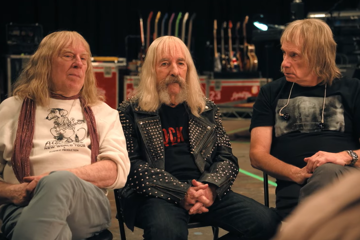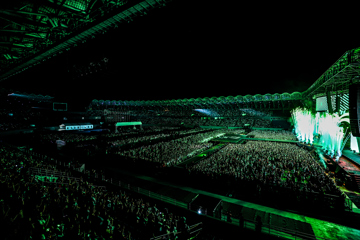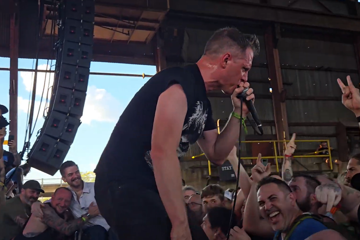'The Dead Don't Die' Might Have A Killer Cast But Is It More Than A 'Trivial Lark'?
"Half-assed not just in its conception and approach, but in its evocation of an explosive theme."
THE DEAD DON’T DIE
★★
Has Jim Jarmusch entered his late-period-Woody-Allen phase? At first, the comparison — downtown dude vs nebbish nerd, cigarettes & coffee vs privilege-class period-pieces, no-wave vs Dixie-jazz — seems off. But, consider The Dead Don’t Die: where a famous New Yorker director ropes a celebrity ensemble cast into a trivial lark that has no reason, beyond the director’s fame, for existing.
And, so, here comes a Jim Jarmusch Zombie Movie, starring Bill Murray, Adam Driver, Tilda Swinton, Chloë Sevigny, Caleb Landry Jones, Selena Gomez, RZA, Tom Waits, Steve Buscemi, Danny Glover, etc, etc. Tackling one of cinema’s most well-trodden genres, Jarmusch fails to capitalise on the symbolic nature of zombie tropes. Instead, he delivers something intended to be an amiable lark, delivered with his tired Gen X predilections: irony, emptiness, an obsession with dude-ish cool.
The fact that we’re post-peak-zombie in pop culture is acknowledged in the text: as soon as a couple of corpses turn up in nondescript Centreville, there’s no naivety as to what’s happening, just instant awareness. “This is undead, reanimated, flesh-eating zombie shit, no question,” spits Waits, as bearded bushman Hermit Bob. “I’m thinking zombies. Ghouls. The undead,” apprises Driver’s aw-shucks cop.
Of course, Driver, in one of the many meta-moments, claims mid-movie that he’s already read the whole script (which irks his partner, Murray). He also has a Star Wars keyring, and Swinton’s Scottish samurai is a riff on her mystical MCU persona. Even if you’re to take moments like these, charitably, as winking fourth-wall-breaking, it’s not particularly funny. But, working in a widely-accessible genre and making reference to his starry stars’ more famous roles, Jarmusch also is treading dangerously close to pandering, multiplex-friendly fan-service.
Beyond the unfunny meta-jokes — zombie Iggy Pop is apparently hilarious? — The Dead Don’t Die tries to scare up some meaning by explicitly evoking genre-godfather George A Romero, and doubling down on the undead being brainless consumers (they mumble “free cable”, “Snapple”, “Siri”, “Bluetooth”, etc). That this zombie uprising is caused by runamok fracking gives a mild air of political parable; here, the pliable symbol of the shuffling undead fingers late-period capitalism in both its endless consumption and in its environmental horrors.
Don't miss a beat with our FREE daily newsletter
“What a fucked-up world,” Waits mutters, at an overrun-with-zombies finale. But it’s no cry of rage against the rule of corporate overlords in a time of ecological crisis, more a world-weary, resigned cry; a ‘c’est la vie’ delivered with a smirk. This symbolises the film as a whole, which is half-assed not just in its conception and approach, but in its evocation of an explosive theme. Rather than feeling like a critique of apathetic acceptance in the face of a climate apocalypse, The Dead Don’t Die just feels apathetic. Or, moreso: it just feels lazy. Much like late-period Woody Allen.
BETWEEN TWO FERNS: THE MOVIE
★★1/2
Speaking of celebrities in on the joke, it’s a Between Two Ferns movie. As in Zach Galifianakis’ popular web series, he plays a comically-inept, brutally-candid cable-access interviewer of actors, all of whom show up to be insulted. For a Netflix feature-length, then, there’s a parade of famous humans: Keanu Reeves, Benedict Cumberbatch, Brie Larson, Gal Gadot, Tessa Thompson, Tiffany Haddish, Jon Hamm, Paul Rudd, etc. Some people herein get to play more of a character — Peter Dinklage, for example, plays himself as someone obsessed with his vast material wealth — but most just show up and gamely play along. For music fans, Phoebe Bridgers and The National’s Matt Berninger even put in an appearance, playing in both a middle-of-nowhere bar and on the soundtrack.
The ‘film’, if we can charitably call it that, is funny enough, but also impossibly slight. Working out how to turn brief conversational barbs with well-known humans into a feature, writer/director Scott Aukerman has quickly sketched out that ultimate American-indie-movie cliché as narrative: a roadtrip. A roadtrip against the clock, no less. It succeeds in padding the plot out to 80 minutes, but does little to make this feel like an artwork that actually needed to be made.
The reason it was made, of course, is to fill out that Netflix menu. Which gives it resonance with Will Ferrell’s self-mocking, familiarly-over-the-top turn as a Funny Or Die mogul obsessed with his website’s clicks. In such, there’s lingering meta-commentary about content creation in the new media landscape, but Aukerman doesn’t truly embrace it. This leaves Between Two Ferns: The Movie as a comedy that delivers laughs, but doesn’t really have anything to say, or much reason to exist.
THE GOLDFINCH
★★
It’s long been a staple of Hollywood filmmaking: option the rights to an acclaimed work of literature, turn it into a prestige picture, and wait for the Oscars to roll in. But, with the ‘content’ landscape so radically changed, and television audiences totally down for storytelling depth, a big screen motion picture is starting to seem like the worst forum for this kind of grand adaptation. As someone who loves cinema, and entering the silent temple of the theatre, even I watched John Crowley’s tonally-off translation of Donna Tartt’s The Goldfinch and thought: maybe it’s time to stop chopping 800-page books down to 150-minute movies.
Given the production was co-financed by Amazon Studios, you wonder why it wasn’t just turned into an eight-hour series. Instead, Crowley (coming off the middlebrow period-piece weepie Brooklyn) and screenwriter Peter Straughan (coming off the disastrous The Snowman) effort to cram all the book’s action into a mandated two-and-a-half hours. Given the source-text is obsessed with details and filled with complexities and interiority, the resulting movie-length adaptation is fighting an uphill battle. A whole section in which the plot resembles an international heist thriller is given about ten minutes, total, of screen-time; brought up and hurried through, making its moments of gunfire feel embarrassingly misplaced, Crowley either uncomfortable or uninterested in giving these sequences real weight, real room.
Instead, lots of stuff happens (Finn Wolfhard, Nicole Kidman, Jeffrey Wright, Luke Wilson, and Sarah Paulson all pay a visit, the latter two overacting wildly), often in abrupt and disorienting fashion, without any of it truly resonating. For a story about loss, trauma, and wounded people trying to heal, the various deaths herein barely register; it’s a tragedy only because Trevor Gureckis’s awful, overdetermined score tells us it is.
The Goldfinch’s plot defies a quick synopsis, but, essentially: 13-year-old Theo (Oakes Fegley) loses his mother in a bomb blast at a gallery, and, in the wake of the destruction, steals a priceless work of art, Carel Fabritius’s titular 1654 painting. From there unfolds an epic picaresque drawn across time and continents (with, here, Ansel Elgort as the adult Theo), filled with antiques, both real and forged.
In the novel, the stolen painting obviously symbolises a tenuous connection to Theo’s late mother, but it’s also a source of constant guilt, a telltale heart which fills our protagonist with constant paranoia and fear, his dark secret ticking like a timebomb. In this adaptation, Crowley wholly fails to bring this to screen. And when a movie version cannot capture the central feeling conveyed by a novel, it can only be deemed a failure.
THE SOUVENIR
★★★★
Twelve years since her way-off-the-radar masterpiece Unrelated — an observational portrait of familial dynamics that boasts Tom Hiddleston’s debut performance — Joanna Hogg is finally having a breakout moment. It’s come with The Souvenir, the first part (The Souvenir Part II is due in 2020) of two movies that function as one coming-of-age study, and carry a hint of memoir. Here, Honor Swinton Byrne plays Julie, a young film student in early-’80s England. Coming from a background of privilege, she’s searching for her identity, as both individual and artist. But her life is derailed by a dysfunctional, on-again/off-again relationship with the older Tom Burke, who she fails to realise is a habitual heroin user.
Essentially, it’s a stark portrait of the behaviours, and the horrors, that people are willing to accept from romantic partners when they’re young, naïve, unsure of themselves. It’s full of things left unsaid, and good old-fashioned English repression. Julie yearns to make social-realist cinema about real working-class lives, but her milieu — and this film — is about, in many ways, the straitjacket of upper-class propriety.
As director, Hogg is again a formalist: her static camera, echoing obvious heroes like Yasujirō Ozu and Chantal Akerman, keenly, even coldly observing the behaviours of people. Her frames are smartly considered: our paramours divided within domestic spaces, half occluded from the image in a bourgeois hotel, or dots in a landscape when returning to Julie’s sprawling country-manor family home. Its final two shots — a look of down-the-barrel frontality, a symbolic opening of a sound-stage door — seem instantly iconic; The Souvenir the work of a director, finally, being welcomed into the spotlight.
BIRDS OF PASSAGE
★★★
Birds Of Passage is almost symbolic of cinema itself. Set amongst Colombia’s indigenous Wayuu, it’s a film depicting a world rarely seen, and speaking in a tongue rarely heard, on screen. There’s incredible cultural specificity here: social customs, rituals, traditions, taboos; and that speaks of cinema’s great capacity to create empathy that transcends barriers of culture and language. Yet, at the same time as this set and setting is unfamiliar, there’s so much about the narrative that’s endlessly familiar. Which speaks of the limits of cinema, as we so often see it: how genre tropes and movie-making conventions can become so entrenched they overpower any kind of individuality or specificity.
In this case, it means we get a Wayuu tale told in Scorsese clichés. Based on ‘true events’ from between 1960-1980, it’s another rise/fall-of-a-drug-empire movie, in which a poor, marginalised ethnic community is transformed when cash from an international weed business starts flowing in. Here comes another tale of ill-gotten riches, ostentatious displays of new-wealth, familial rivalries, power-grabs and double-crosses and dishes of revenge served cold, with plentiful barrages of gunfire.
Co-director Ciro Guerra (credited alongside Cristina Gallego) was last seen helming the psychedelic colonialism parable Embrace Of The Serpent. Where that film was famous for its bleached black-and-white images — which evoked old newsreel footage and ethnographic daguerrotypes — here Guerra and Gallego use bright colours, especially splashes of red which contrast with the oft-stark landscape. Birds Of Passage is, again, about the collision between traditional tribal life and the modern nation-state of Colombia, something symbolised by a newly-built modernist palace in the remote village, which looks like a gilded box dropped upon the cracked desert flats. The narrative rise and fall becomes, within the narrative, another piece of passed-down folklore to live on in the Wayuu’s oral tradition. The directors make explicit connections between traditional storytelling and the modern storytelling of cinema. But, ultimately, you wish there was more of the former, less of the latter; this playing like a genre movie dressed in ethnographic threads.
BUOYANCY
★★★
Buoyancy is an Australian film that shows the ever-expanding notion of what that can be. Debutante director Rodd Rathjen shot the film entirely on location in — and off the coast of — Cambodia, and chronicles a young Cambodian (Sarm Heng) who leaves home in search of work, only to find himself trapped on a Thai fishing boat, forced to haul nets for his freedom. It was based on the endless testimonies of survivors of indentured fishing-trawler toil, and the local playing the movie's sadistic captain, Thanawut Kasro, once suffered this ill fate himself.
At its worst, Buoyancy feels a little like a ‘plight of’ movie, full of earnest concern and unchecked pity. But at its best it works as a micro narrative suggesting a macro problem, dramatising the modern-day slavery at play among the South-East Asian fishing industry (where the caught fish largely end up in Western pet food). Here, the child/slave-labour workers are mere grist for amoral globalist trade, the human bycatch in an international economic system built — as always — upon exploitation.
In depicting this personalised experience therein, Rathjen delivers something forceful, almost deliberately blunt; a coming-of-age nightmare that moves towards a thriller in its shaped narrative. It’s not dramatically profound, but beyond its simplicity and pity, Buoyancy offers a great, human riposte against the horrors of unchecked globalism.







